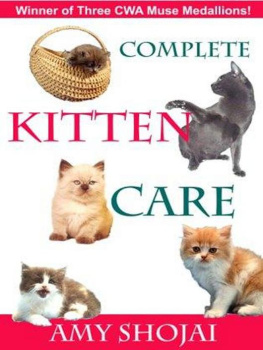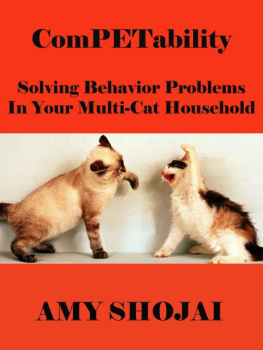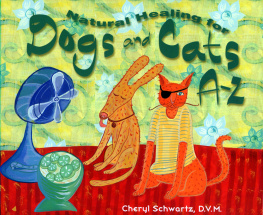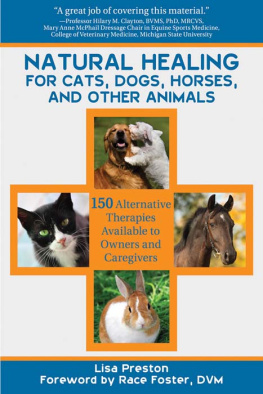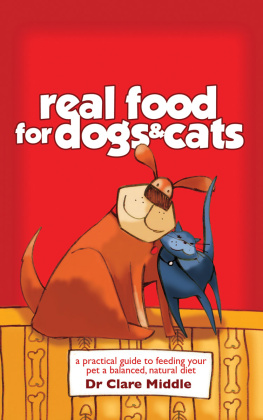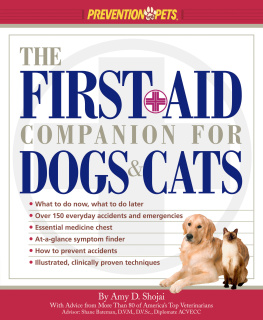
N otice
This book is intended as a reference volume only, not as a medical manual. The information given here is designed to help you make informed decisions about your pets health. It is not intended as a substitute for any treatment that may have been prescribed by your veterinarian. If you suspect that your pet has a medical problem, we urge you to seek competent medical help.
1999 Rodale Inc.
Illustrations 1999 Randy Hamblin and Jim Starr
Cover photograph FotoJagodka
All rights reserved. No part of this publication may be reproduced or transmitted in any form or by any means, electronic or mechanical, including photocopying, recording, or any other information storage and retrieval system, without the written permission of the publisher.
Prevention and Prevention for Pets are registered trademarks of Rodale Inc.
2016 Editions by Furry Muse Publishing in special arrangement with Rodale Inc. Visit Amy Shojai on the Web at www.SHOJAI.com
O UR P URPOSE
We help you give your pets all the good health and loving care they deserve. In our books, you will find the latest information along with the wisdom and practical advice of the countrys top veterinary experts. From behavior and training tips to improving quality of life, we will help you achieve the greatest reward of alla lifetime of love and commitment.

P revention for Pets Board of Advisors
C. A. Tony Buffington, D.V.M., Ph.D ., professor of clinical nutrition at the Ohio State University Veterinary Hospital in Columbus
Karen L. Campbell, D.V.M ., associate professor of dermatology and small animal internal medicine at the University of Illinois College of Veterinary Medicine at UrbanaChampaign
Liz Palika , a columnist for Dog Fancy magazine; owner of Dog Training with Liz obedience school in Oceanside, California; and author of All Dogs Need Some Training
Allen M. Schoen, D.V.M ., affiliate faculty member in the department of clinical sciences at Colorado State University in Fort Collins; director of the Veterinary Institute for Therapeutic Alternatives in Sherman, Connecticut; and author of Love, Miracles, and Animal Healing
John C. Wright, Ph.D ., a certified applied animal behaviorist; professor of psychology at Mercer University in Macon, Georgia; and author of The Dog Who Would Be King
Foreword
It wasnt long after starting practice that I found myself getting frustrated. Some pets, even those with seemingly simple problems, never seemed as healthy as they should be. They were getting all the right treatments, but the treatments were often causing symptoms of their own. And when I gave pets their yearly vaccines, I kept noticing that they often had dry, smelly coats or were scratching or their energy wasnt goodthings that most veterinarians considered fairly normal.
After a while, my frustration turned into a plan. When my patients werent getting better, I decided that I would look beyond the standard practices and expert opinions. I became a scout for emerging therapies.
I was amazed how many there were. Some Id heard of, but others were entirely new to me. I had to remind myselfas doctors shouldthat these unfamiliar (to me) therapies just might work, even though I hadnt tried them yet. And often they did.
Im still a great believer in mainstream veterinary medicine. But along with other veterinarians worldwide, I have learned that although modern medicine offers many miracles, it cant do everything. I have found from years of experience that dogs and cats dont always need the strongest drugs or the most invasive surgery. Even when they do need mainstream help, treatments such as nutritional supplements, massage, and perhaps even energy therapies can provide them with the extra fuel they need to get well and stay well.
You may be told that these remedies are not scientifically proven. This is usually true. And you may be told not to bother with them because they cannot possibly work. This is not true. Not every remedy in this book will work for every pet. Some of these remedies I use every week, and some I have never tried. The point is that petsand their ownersare individuals, not bound to live by statistics. I say give these remedies a try. In many cases, they could make a world of difference.

Susan G. Wynn, D.V.M.
Contents
PART 1
A New
Approach

CHAPTER 1: Healing the Natural Way
V eterinary medicine used to be a lot simpler. Without a lot of equipment to lug around, vets made house calls, dispensing medicines along with the wisdom of years of experience. They got to know the families they worked with and had special insights into pets liveswhat they ate, how they spent their days, and what their usual energy was like. They looked at symptoms, too, but only as one part of a larger picture.
As technology advanced and veterinarians got more sophisticated, some of this personal touch was lost. Most vets stopped making house calls, and you almost never see them take pills or mysterious liquids out of a battered black bag. As with human doctors, modern vets still depend on good old-fashioned horse sense but rely more on the latest tests and techniques, like magnetic resonance imaging, keyhole surgery, and computer-designed medications.
For pets with serious injuries, this modern approach is hard to beat, says David H. Jaggar, D.C., M.R.C.V.S. (member of Royal College of Veterinary Surgeons, a British equivalent of D.V.M.), a holistic veterinarian and chiropractor in Boulder, Colorado, and a founder of the International Veterinary Acupuncture Society. It has limitations, however. Some veterinarians dont have time anymore to get to know their patients very well. When owners take their pets into the office, some vets will focus mainly on the symptoms in order to prescribe a specific treatment. For instance, a dog with hip dysplasia might be given steroids to relieve swelling and perhaps have surgery done to repair or replace the damaged joint. This relieves the immediate symptom, but it may not resolve the underlying problems that made the joint vulnerable in the first place, says Dr. Jaggar. And the treatments themselves may cause additional problems.
Veterinarians who specialize in holistic medicine feel that there is a better way. Without rejecting the many advances of modern medicine, they have shifted their focus to an older style of care. They may spend more time with pets in order to understand their personalities and lifestyles. More important, they look at physical and emotional problems as pieces of a larger puzzle. Illness is rarely caused by something as obvious as a weak joint, bacteria in the body, or pollen. In the holistic view, pets get sick because something happened that allowed external factors to cause illness. Unless you strengthen the body, dogs and cats will continue to get sick.
Next page

